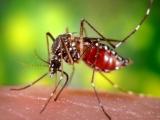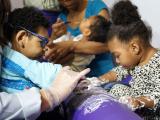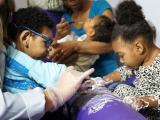The US Centers for Disease Control and Prevention (CDC) today reported a range of complications at a level higher than they expected in nine pregnant US women who had travel-related Zika infections.
Also, the CDC released a report on six sexual transmission cases—some involving pregnant women—that are furthest along in the investigation process, and the Food and Drug Administration (FDA) today issued an Emergency Use Authorization (EUA) for a Zika virus immunoglobulin (IgM) antibody test (Zika MAC-ELISA), clearing the way for its rollout to labs in the CDC's Laboratory Response Network.
A range of pregnancy outcomes
The CDC today released information on nine pregnant travelers from the United States who had lab-confirmed Zika virus infections, with outcomes ranging from early miscarriages to one severe microcephaly case to two apparently healthy infants. It detailed the cases today in an early edition of Morbidity and Mortality Weekly Report (MMWR).
The CDC said it is also investigating 10 more reports of Zika illness in pregnant travelers.
At a media briefing on the reports today, CDC Director Tom Frieden, MD, MPH, said it's too soon to draw any firm conclusions about the link between Zika virus and complications in pregnancy, but there might be a period of increased risk when pregnant women are infected with Zika virus during the first trimester.
He said there are still many unanswered questions, such as whether there are cofactors that contribute to the increased microcephaly risk and if there are any future complications in healthy babies born to mothers who had infections during their pregnancies.
"We're literally learning more about Zika virus every day," he said, repeating that the CDC's bottom-line messages are that pregnant women should postpone travel to affected areas, take precautions against mosquitoes, and follow advice on preventing sexual Zika transmission.
Women included in today's report had traveled to one or more of nine countries reporting local Zika virus transmission: American Samoa, Brazil, El Salvador, Guatemala, Haiti, Honduras, Mexico, Puerto Rico, and Samoa.
All nine had reported at least one Zika symptom, and eight had at least two symptoms. The CDC said seven had reported fever during pregnancy, which is known to increase the risk of adverse pregnancy outcomes, including neural tube defects. None of the women were hospitalized or died from their infections.
Two of the women miscarried in the first trimester of pregnancy, and though Zika virus was found in fetal specimens from both cases, the CDC said it's not known if the virus caused the miscarriages.
In two of the pregnancies, women decided to terminate their pregnancies. One of them made the decision after an ultrasound and fetal magnetic imaging at about 20 weeks showed brain atrophy and amniocentesis was positive for Zika virus RNA.
Two of the pregnancies are continuing without any known complications, one at 18 weeks gestation and the other at 34 weeks.
Of three live births, two babies are apparently healthy and one has severe microcephaly.
At today's briefing, Denise Jamieson, MD, MPH, coleader of the pregnancy and birth defects team for the CDC's Zika response, said the CDC has established a pregnancy registry to follow such cases and has established an around-the-clock consultation service for doctors. Frieden added that the CDC Foundation is rolling out free Zika prevention kits for pregnant women in affected US territories. They contain insecticide, tablets for treating standing water, and other supplies.
Sexual transmission patterns
Earlier this week the CDC said it was investigating 14 new reports of possible sexual transmission of Zika virus from returning male travelers to their nontraveling partners, and today it provided details on six cases in a separate MMWR report. Of the 14 cases, 2 have been ruled out and investigations are still under way for 6.
Frieden told reporters that although the CDC expected to see to see continued rapid spread of the disease and an increasing number of cases in travelers returning to the United States, the growing number of sexually transmitted cases has been a surprise. Overall, 107 Zika infections have been reported in US travelers, and 40 local infections have been reported in US territories—most of them in Puerto Rico.
Paul Mead, MD, MPH, one of the CDC's investigators, said the CDC received numerous reports of cases of suspected sexual transmission from multiple states after it announced the first case in the current outbreak, in a patient from Texas, and issued its guidance on preventing such exposure to pregnant women. He said health officials are investigating each report, which can take weeks for interviews and lab tests to be completed.
Two of the six cases in today's MMWR report are lab confirmed, and the other four are listed as probable infections. In all six cases men returning from affected areas—while they had Zika symptoms or shortly after—were thought to have passed the virus to their female partners during condomless sex. "That doesn't mean transmission later isn't possible," Mead said, adding that it will take several months for tests on Zika virus persistence in semen to be completed.
According to the report, the median age of the infected partners is 22.5 years (range, 19 to 55), and several of the women are pregnant.
For patient privacy purposes, the CDC didn't list states for the patients. But the Oregon Health Authority (OHA) today announced its first sexually transmitted Zika infection, spread by a man who had traveled to a Zika-hit country to his female sex partner who had not traveled. In its statement, the OHA said both the man and woman later tested positive for Zika virus.
Lab test progress
In the FDA's EUA approval letter, it said the Zika MAC test has been cleared for detecting evidence of the virus in human sera or cerebrospinal fluid. Frieden said it took just weeks to scale up production of the CDC-developed test and get regulatory clearance.
"This is an encouraging step forward," he said.
Julie Villanueva, PhD, the CDC's lab team lead for its Zika response, said the test is used to gauge recent infection and can detect the virus as early as 4 days after symptoms begin.
Other developments
- The World Health Organization (WHO) said today in its weekly assessment on Zika virus and its complications that two more locations in the Americas are reporting locally acquired Zika: Saint Vincent and the Grenadines and the Dutch territory of Sint Maarten. The new reports raise the number of affected nations or territories in the Americas to 31.
- Also today the WHO issued initial guidance covering psychosocial support for mothers and families potentially affected by Zika-linked microcephaly. The WHO said the guidance, aimed at health providers, is also useful for those affected by other possible neurologic complications, such as Guillain-Barre syndrome. The 18-page document covers accurate portrayal of health information, reactions to expect, basic psychosocial support, strengthening social support, stress reduction, and parenting. WHO experts developed the guidance, which was peer-reviewed by experts mainly drawn from nongovernmental health organizations.
- Based on a query and feature story on Zika virus rumors from NBC News, Peter Sandman, PhD, and Jody Lanard, MD, well-known risk communicators based in Brooklyn, N.Y., addressed the issue yesterday in greater detail in a commentary on their Web site, their third installment tackling Zika issues. They said rumors are to be expected, especially in settings of public mistrust and expert uncertainty and that rebutting rumors requires taking them seriously. The WHO on Feb 19 also addressed some of the rumors.
See also:
Feb 26 MMWR report on pregnancies
Feb 26 MMWR report on sexual transmission cases
Feb 26 OHA statement
Feb 26 FDA EUA letter
Feb 26 WHO weekly Zika outbreak situation update
Feb 26 WHO guidance
CDC Zika virus in the United States page
Feb 25 NBC News report
Feb 25 Sandman and Lanard risk communication commentary





















